|
|
Luigi at the OK Corral
or Why the Europeans Made the More Effective and Artistic Cinematic Westerns.
By Heather Drain
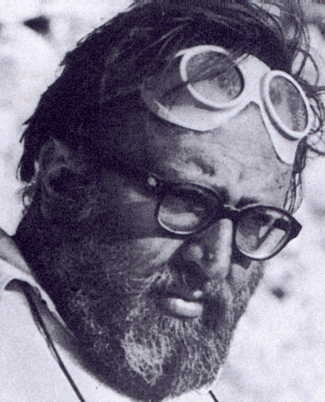 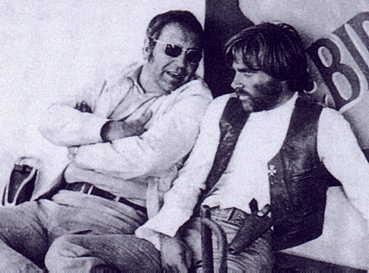 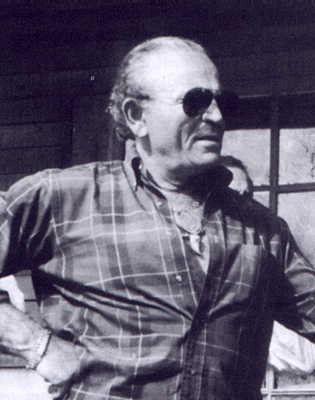
Three masters of the Spaghetti Western : Sergio
Leoni (R) Sergio Corbucci (M - with Franco Nero) and Enzio G. Casterelli.
In the history of film, one would be hard pressed to find a more genuinely
American genre than the Western. Unlike other genres, such as comedy and
drama, whose roots can be traced back to the ancient Greeks, the western
is a born and bred American genre. It has it’s own set of heroes,
rules, archetypes and history. Not to mention it was considered for many
years to be a very narrow genre. With a film that’s a melodrama,
you have a good range of options and situations that can appeal to the
human condition. Westerns you are far more limited on what you can do.
For being such an infant genre, it quickly established it’s own
formula in the US. You had rough and tumble men like John Wayne ruling
the roost, alongside the more wholesomely rugged types like Tex Ritter
and Gene Autry. The good guys wore white and the bad guys wore black.
If there were prostitutes, they always had hearts of gold, despite the
fact that hero would end up with someone like the preacher’s daughter.
After all, he can’t end up with used goods, even if he had a part
in the using. Apropos for Hollywood, there was always a happy ending.
The hero gets the girl and the bad guy finds a violent, albeit cleanly
bloody end.
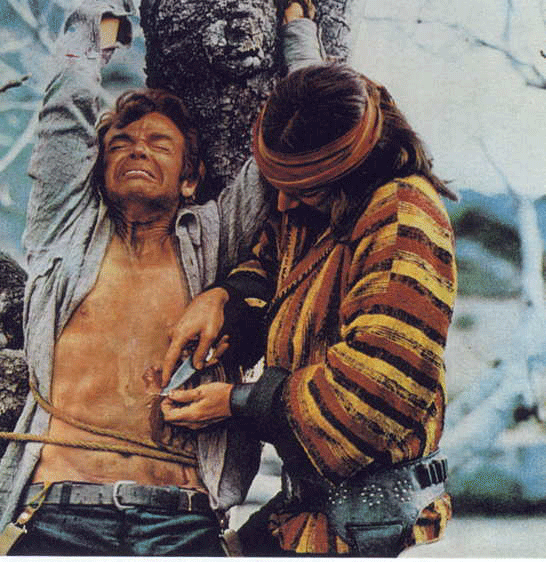
Thomas Milian torturing a sheriff in Lucio
Fulci's brilliant Four of the Apocalypse.
Milian is a popular charector actor who appeared in countless Spaghetti
Westerns playing both good guys and bad guys. In this film he's the bad
guy, obviously!
Remarkably, for being such a purely American genre, the western found
popularity overseas. Despite all the rules and archetypes, there was something
about the form that spoke out to people. Maybe it was the sexiness of
violence in the desert? Or maybe it was the idea of living in a land where
law is a tenuous thing and man’s more primal side can come into
full play? With a few minor exceptions, no one overseas had really tried
their hand at a tried and true Western until the 1960’s and it was
from the most unlikely of places; Italy and to a lesser degree, Spain,
France and West Germany. Back then it must have seemed nearly impossible
for the western to be truly reinvented. Especially by a bunch of Europeans,
no less! Yet, somehow it was done. At the time, the western as a genre
was rich with unfulfilled potential. While there were some American directors
who pushed as many boundaries as they could, they were still stymied by
the Hays code and the constant push to make a commercially viable film.
So it took a couple of foreigners to add a whole new spin to the form.

Klaus Kinski made a career appearing in arthouse
swill such as Aquirre - Wrath
of a Warrior while also appearing in countless Euro
sleazefests such as Slaughter Hotel and
countless Spaghetti Westerns.
When it comes to character use, few things stand out more from the Spaghetti
Westerns than the classic “anti-hero.” Sure, the Europeans
were not the first to use the questionable hero, by far. But they were
the first to fully establish it as a neo-classic role in Westerns. An
obvious example of this would be Clint Eastwood in such Serge Leone films
as “A Fistful of Dollars” (1964) and “The
Good, the Bad, and the Ugly.” (1966) Instead of being moralists
in scruffy guise, the heroes of Spaghetti Westerns were slightly less
questionable than the villains. In other words, if they were wearing white,
it was most likely stained by dried blood, old sweat, and layers of dirt.
This is one of the things I adore, because to survive in such an extreme
and constantly dangerous environment, it would be difficult for one to
remain completely moral. The old Wild West could definitely bring out
“the lesser of evils” when it comes to mankind, perhaps just
as much if not more than today’s urban environment. To have this
harsh, survivalist element in these films fits like a leather glove. In
real life, the lines of good and bad, black and white are continually,
if not eternally blurred. To have this murky gray area somewhat explored
is always an exciting and somewhat necessary thing in the world of art
and movies. Where better than a western?
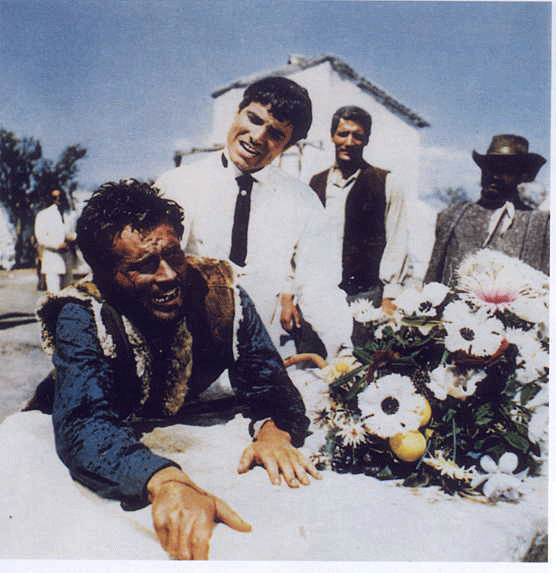
Franco Nero, Christ like hero of many Euro
westerns, including Django,
here being used as a whipping post in Lucio Fulci's
Colt Concert.
With this foggier sense of morality, comes the strong potential of a darker,
non-traditional ending. Even when the ending was “happy,”
it was often the less jubilant kind. Like all was well for that day, but
the feeling that the next day would bring more hardship and violence was
always there. For some of these films, a happy ending is practically a
small pittance in a dirty and bloody world. Some of the Spaghetti westerns
went a step further and opted for a full out, bleak ending. One of the
most striking examples of this is Sergio Corbucci’s “Il
Grande Silenzio/The Great Silence” (1968), which featured
an untraditional hero with a tragic life and a film with an even more
tragic ending.
One of my personal favorite things about Spaghetti Westerns is that they
always had the best casting. So many of them were a virtual character
actor buffet. Since character actor tends to be another word for an actor
who is more interesting looking physically and more talented than your
usual A-lister pretty boy, things are rarely boring acting-wise. Not that
there weren’t any handsome men in the Euro-western universe. One
look at the classic handsomeness of Terrence Hill, will tell you that
much. Some of the other actors ranged more, both in talent and physicality.
Look at the great actor Klaus Kinski in Sergio Leone’s “For
a Few Dollars More” (1965). Sure he’s a hunchback
in it, but he has to be the world’s most strangely attractive hunchback
ever. Then look at him in “A Genius, Two Partners, and a
Dupe” (1975), where he looks almost more vampiric than
he did in Herzog’s “Nosferatu.” (1979)
But for every attractive Euro-western actor, you had some more unique
and wonderfully distinctive looking actors. Who can forget the slightly
rodent-esque features of Lee Van Cleef or the swarthy, corpialness of
Bud Spencer? It’s safe to say that every main Spaghetti Western
actor had a face you could never forget.
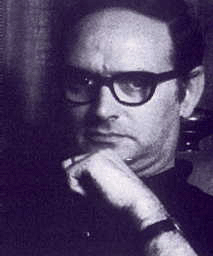 Now,
out of all of these great cinematic elements, the most striking and memorable
have to be the music. Spaghetti Westerns have had some of the best soundtracks
ever. When you look at some of the composers that worked on those films,
it makes crystalline sense. The biggest known composer was, of course,
Ennio Morricone, who is still doing film work in 2004. In addition to
his legendary work with Sergio Leone, he was also behind the scores for
such notable works as “Death Rides a Horse”
(1968) and “Duck, You Sucker.”(1971) More
hearty journalists can and have tried to sum up his 400+ film career,
but needless to say his impact was huge and even reaching outside the
film music world, reaching such diverse bands as Wall of Voodoo and Metallica.
Another terrific and prolific composer is Luis Enriquez Bacalov, who is
most probably most famous for his excellent and way too catchy work in
“Django.” (1966) (Oddly enough both Morricone
and Bacalov worked with infamous Italian director Pier Paolo Pasolini.
Morricone scored “The Arabian Nights” (1974)
and “Salo, or the 120 Days of Sodom” (1975).
Bacalov scored the music for “The Gospel According to St.
Mathew.” (1964) Bacalov also worked on another Spaghetti
classic, “A Bullet for the General” (1967) Now,
out of all of these great cinematic elements, the most striking and memorable
have to be the music. Spaghetti Westerns have had some of the best soundtracks
ever. When you look at some of the composers that worked on those films,
it makes crystalline sense. The biggest known composer was, of course,
Ennio Morricone, who is still doing film work in 2004. In addition to
his legendary work with Sergio Leone, he was also behind the scores for
such notable works as “Death Rides a Horse”
(1968) and “Duck, You Sucker.”(1971) More
hearty journalists can and have tried to sum up his 400+ film career,
but needless to say his impact was huge and even reaching outside the
film music world, reaching such diverse bands as Wall of Voodoo and Metallica.
Another terrific and prolific composer is Luis Enriquez Bacalov, who is
most probably most famous for his excellent and way too catchy work in
“Django.” (1966) (Oddly enough both Morricone
and Bacalov worked with infamous Italian director Pier Paolo Pasolini.
Morricone scored “The Arabian Nights” (1974)
and “Salo, or the 120 Days of Sodom” (1975).
Bacalov scored the music for “The Gospel According to St.
Mathew.” (1964) Bacalov also worked on another Spaghetti
classic, “A Bullet for the General” (1967)
An ingredient that is usually overlooked by a lot of film critics is the
title. Titling a work is one of those things that seems deceptively simple
but can have a huge effect on whether someone is going to give that film
a chance or not. Italian cinema in general has a history of wild and colorful
titles. This is doubly so for the Spaghetti Westerns. Not that “High
Noon” (1952) is not a great film title, but can it really
compete with something like “God Forgives . . .I Don’t!”
(1968) or “Shoot the Living and Pray for the Dead?”
(1970) I highly doubt it. The Sartana series alone has some incredible
titles, such as “Light the Fuse…Sartana is Coming”
(1970) “Sartana’s Coming, Get your Coffins Ready,”
(1970) and “Have a Good Funeral, My Friend…Sartana
Will Pay.” (1970) Still don’t believe me? Then contemplate
other striking titles, such as “And Crows Will Dig Your
Grave” (1972), “And They Smelled the Strange,
Exciting, Dangerous Scent of Dollars,” (1973) and “A
Sky Full of Stars for a Roof.” (1968)
While there are many, many fine American westerns that have had a great
impact on cinema as a whole, it is always important to remember their
swarthier, more brooding European brothers. Now go make some cappellini
pomodoro and pop in a movie with a character named Sartana, Django, or
Trinity.
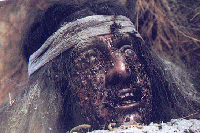

|
 |

